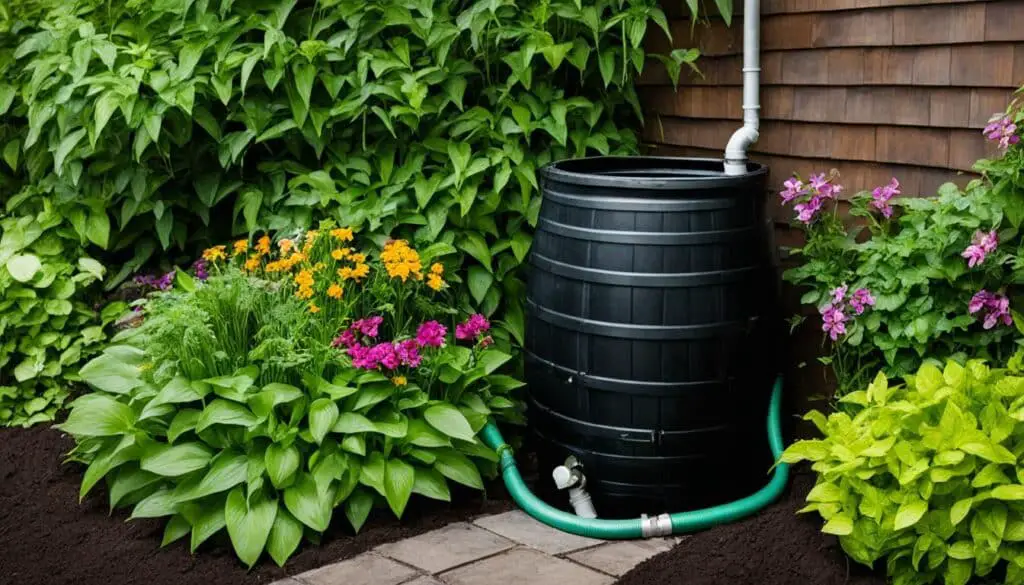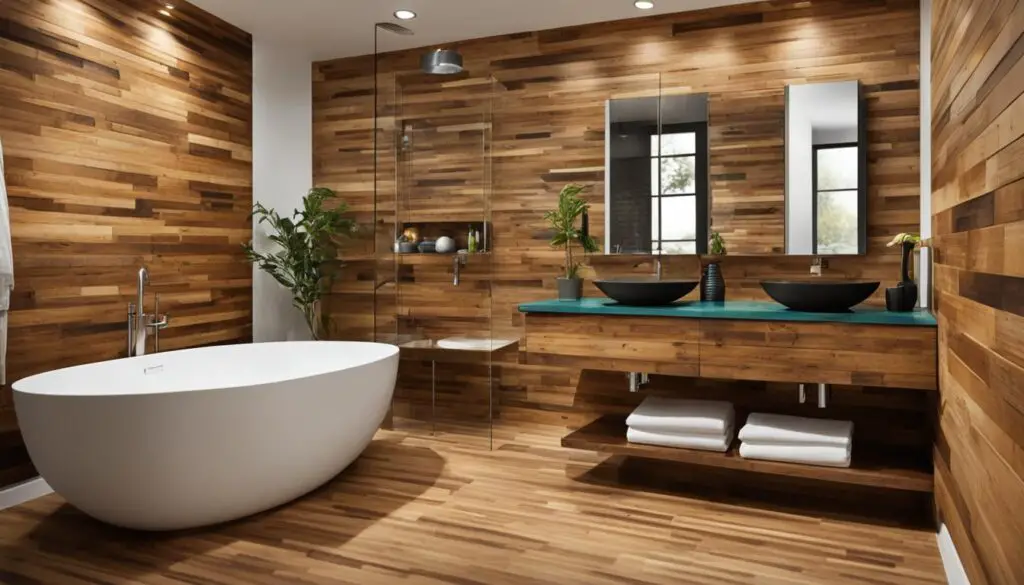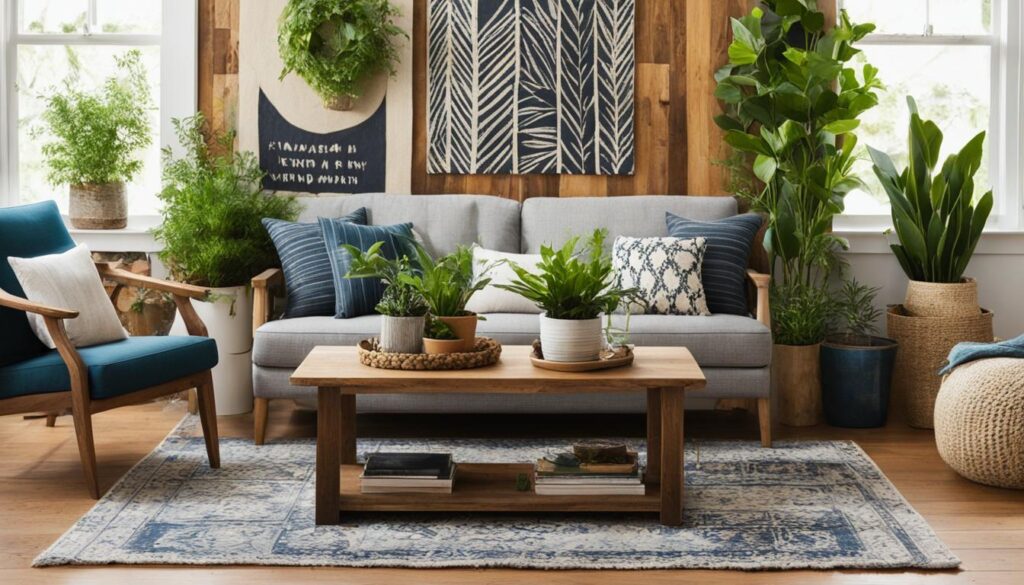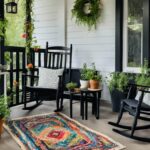In this section, I will explore various affordable DIY eco-friendly home improvement ideas that can transform your space and benefit the planet. These ideas are not only cost-effective but also environmentally friendly, allowing you to create a greener and more sustainable home.
With a little creativity and some basic tools, you can make a significant impact on your home’s eco-friendliness without breaking the bank. Whether it’s implementing energy-saving measures, incorporating recycled materials, or adopting water conservation techniques, there are numerous ways to make your home more sustainable.
By embracing green renovation practices, you not only reduce your carbon footprint but also create a healthier living environment for you and your family. Plus, the cost savings from reduced energy and water consumption can add up over time, making these improvements even more appealing.
From small changes like swapping out light bulbs to larger projects like installing rainwater harvesting systems, there are DIY options for every budget and skill level. So, let’s dive in and discover how you can make your home greener and more eco-friendly.
Table of Contents
Key Takeaways:
- Implementing eco-friendly home improvements is affordable and environmentally friendly.
- DIY projects can transform your space and benefit the planet.
- Green renovations can lead to cost savings through reduced energy and water consumption.
- There are numerous DIY eco-friendly ideas for every budget and skill level.
- Creating a greener home promotes a healthier living environment for you and your family.
Energy Efficiency Upgrades for a Greener Home
In this section, I will focus on energy efficiency upgrades that can make your home more eco-friendly. By implementing these upgrades, you can reduce energy consumption, lower utility bills, and contribute to sustainable living.
One simple change you can make is replacing traditional light bulbs with LED bulbs. LED bulbs are more energy-efficient and last longer, helping you save money on electricity costs in the long run. Additionally, LED bulbs produce less heat, making them safer to use.
Another upgrade is installing programmable thermostats. These thermostats allow you to optimize heating and cooling in your home, ensuring that energy is not wasted when you’re away or asleep. By setting a schedule and maintaining a comfortable temperature only when needed, you can significantly reduce your energy consumption.
To further improve energy efficiency, consider adding insulation to your home. Insulation helps prevent heat loss during winter and heat gain during summer, reducing the need for excessive heating or cooling. This not only saves energy but also enhances the overall comfort of your living space.
“Energy efficiency upgrades not only help the environment but can also save you money in the long run by reducing your utility bills.”
Implementing these energy efficiency upgrades not only helps to preserve the planet’s resources but also benefits your household finances. By reducing energy consumption, you can lower your utility bills, saving money over time.
Make your home more energy-efficient today and take a step towards sustainable living.
| Energy Efficiency Upgrades | Benefits |
|---|---|
| Replace traditional light bulbs with LED bulbs | Reduces electricity consumption, longer lifespan, lower heat emission |
| Install programmable thermostats | Optimizes heating and cooling, reduces energy waste |
| Add insulation to your home | Prevents heat loss and gain, reduces the need for excessive heating or cooling |
Water Conservation Techniques for a Sustainable Home
In this section, we will explore effective water conservation techniques that you can implement in your home to reduce water consumption and promote sustainable living. By adopting these eco-friendly practices, you can play an active role in conserving water resources and cultivating an eco-friendly home environment.
1. Install Low-Flow Fixtures
One of the simplest ways to reduce water waste is by installing low-flow fixtures in your home. These fixtures, such as low-flow showerheads and faucets, are designed to use less water without compromising on performance. By replacing old, inefficient fixtures with low-flow alternatives, you can significantly reduce your water consumption and contribute to water conservation efforts.
2. Utilize Rainwater Harvesting Systems
Rainwater harvesting systems provide an excellent opportunity to reduce reliance on municipal water sources for non-potable water needs. These systems collect rainwater from roofs and store it for later use in tasks like irrigation, outdoor cleaning, and toilet flushing. By utilizing rainwater, you can minimize freshwater consumption and conserve this valuable resource.
3. Fix Plumbing Leaks Promptly
Plumbing leaks can lead to significant water wastage, both indoors and outdoors. It’s crucial to promptly address any leaks in faucets, toilets, or irrigation systems to prevent unnecessary water loss. Regularly inspecting your plumbing and fixing leaks as soon as they are detected can make a significant difference in reducing water consumption and conserving water resources.
“Water conservation is not just about saving water; it’s about transferring responsibility towards a sustainable future.”
Implementing these water conservation techniques in your home can contribute to a more sustainable and eco-friendly lifestyle. By reducing water consumption and implementing eco-friendly practices, you can make a positive impact on the environment and promote responsible water usage.

| Water Conservation Techniques | Benefits |
|---|---|
| Install low-flow fixtures | Reduces water waste without compromising performance |
| Utilize rainwater harvesting systems | Minimizes reliance on municipal water sources |
| Fix plumbing leaks promptly | Prevents unnecessary water loss and wastage |
Eco-Friendly Materials and Finishes for Sustainable Renovations
When it comes to sustainable renovations and green building, using eco-friendly materials and finishes is key. These alternatives not only reduce our environmental impact but also contribute to healthier indoor spaces. In this section, I will discuss some of the top eco-friendly materials and finishes that you can incorporate into your home renovations.
Reclaimed Wood
One of the most popular choices for eco-friendly renovations is reclaimed wood. This refers to wood that has been salvaged from old buildings, barns, or other structures and repurposed for new projects. By using reclaimed wood, you not only reduce the demand for new timber but also give new life to discarded materials. It adds a unique charm and character to any space while reducing deforestation.
Recycled Glass Countertops
Another great option for sustainable renovations is recycled glass countertops. These countertops are made from crushed and recycled glass, such as discarded bottles or broken windows, mixed with a binder material. Not only do they offer a beautiful and unique aesthetic, but they also reduce the amount of waste that ends up in landfills. Recycled glass countertops are durable, easy to maintain, and come in a variety of colors and designs to suit any style.
Low VOC Paint
When it comes to environmentally friendly finishes, choosing low VOC (Volatile Organic Compounds) paint is a smart choice. Traditional paints contain high levels of VOCs, which can release harmful chemicals into the air, contributing to indoor air pollution. Low VOC paint, on the other hand, has significantly lower levels of these toxic compounds, making it a safer option for you and your family. It also helps improve indoor air quality and reduces your carbon footprint.
| Material | Benefits |
|---|---|
| Reclaimed Wood | – Reduces deforestation – Adds character and charm – Repurposes discarded materials |
| Recycled Glass Countertops | – Reduces waste in landfills – Durable and easy to maintain – Offers unique aesthetic |
| Low VOC Paint | – Improves indoor air quality – Reduces harmful emissions – Safer for you and the environment |

By incorporating these eco-friendly materials and finishes into your sustainable renovations, you can create a space that is not only aesthetically pleasing but also environmentally conscious. From reclaimed wood to recycled glass countertops and low VOC paint, these options offer both style and sustainability. Make a positive impact on the planet while improving your home with these eco-friendly choices.
Indoor Air Quality Improvements for a Healthy Home
Creating a healthy home environment goes beyond just aesthetics; it also involves improving indoor air quality. Poor indoor air quality can lead to respiratory issues, allergies, and other health concerns. In this section, we will explore effective ways to enhance the air quality in your home, ensuring a healthier living environment for you and your family.
The Benefits of Indoor Air Quality Improvements
Indoor air quality improvements offer numerous benefits, including:
- Reduced risk of respiratory ailments and allergies
- Enhanced overall well-being and comfort
- Increased productivity and cognitive function
- Lowered exposure to harmful pollutants and toxins
Investing in these improvements is a proactive step towards creating a healthy home environment for everyone to enjoy.
Using Eco-Friendly Cleaning Products
Traditional cleaning products often contain harmful chemicals that can pollute the air indoors. To maintain good indoor air quality, switch to eco-friendly cleaning products. These products are formulated using natural ingredients that are safe for both your health and the environment. Look for products that are labeled “green,” “eco-friendly,” or “biodegradable.” Not only will this help reduce the impact of harmful chemicals on indoor air, but it will also minimize your exposure to toxins and pollutants.
Ventilation Systems for Fresh Air Circulation
Adequate ventilation is crucial for maintaining good indoor air quality. Proper airflow helps to remove stagnant air and replace it with fresh air from outside. Consider installing ventilation systems, such as exhaust fans or air purifiers, in key areas of your home. These systems effectively remove pollutants, odors, and humidity, ensuring a continuous supply of fresh air. Additionally, opening windows and doors periodically can facilitate natural air circulation.
Natural Air Purification with Houseplants
Houseplants not only add beauty to your home but also act as natural air purifiers. Certain plants, such as Boston ferns, peace lilies, and snake plants, have the ability to remove toxins and improve indoor air quality by releasing oxygen and absorbing harmful substances. Place these plants strategically throughout your home, particularly in areas with limited ventilation or where pollutants are commonly found, such as the kitchen and bathroom.
By implementing these indoor air quality improvements, you can create a healthier home environment for you and your loved ones. Switching to eco-friendly cleaning products, ensuring proper ventilation, and incorporating houseplants into your decor are practical and effective ways to enhance indoor air quality. Breathe easier knowing that you have taken steps towards a healthier and more comfortable living space.
Conclusion
In conclusion, implementing DIY eco-friendly home improvement ideas not only allows you to transform your space but also benefits the planet. By embracing energy efficiency upgrades, water conservation techniques, eco-friendly materials, and indoor air quality improvements, you can create a greener and more sustainable home.
These improvements are surprisingly affordable and easy to implement, making them accessible to anyone. Whether it’s replacing traditional light bulbs with energy-saving LED bulbs, installing low-flow fixtures to reduce water consumption, using eco-friendly materials like reclaimed wood, or improving indoor air quality with ventilation systems, every small step counts in contributing to a healthier and more eco-friendly lifestyle.
By taking a DIY approach, you have the flexibility to incorporate these changes at your own pace and according to your budget. Start your green renovation journey today and be part of the solution for a more sustainable future. Remember, every action you take towards eco-friendly home improvement ideas makes a difference for both your own wellbeing and the health of the planet.
FAQ
What are some affordable DIY eco-friendly home improvement ideas?
Some affordable DIY eco-friendly home improvement ideas include replacing traditional light bulbs with LED bulbs, installing programmable thermostats, and adding insulation to reduce energy loss.
How can energy efficiency upgrades benefit my home and the environment?
Energy efficiency upgrades can reduce energy consumption, lower utility bills, and contribute to a more sustainable lifestyle by reducing carbon emissions and decreasing reliance on non-renewable energy sources.
What water conservation techniques can I implement in my home?
You can install low-flow fixtures, use rainwater harvesting systems for irrigation, and fix plumbing leaks to reduce water waste and contribute to a more sustainable and eco-friendly lifestyle.
What are some eco-friendly materials and finishes I can use in my home renovations?
Some eco-friendly materials and finishes to consider for sustainable renovations include reclaimed wood, recycled glass countertops, and low VOC (Volatile Organic Compounds) paint. These alternatives are better for the environment and promote healthier indoor air quality.
How can I improve indoor air quality in my home?
You can improve indoor air quality by using eco-friendly cleaning products, implementing ventilation systems to circulate fresh air, and adding houseplants that can naturally purify the air. These improvements create a healthier living environment and reduce exposure to harmful pollutants.
Source Links
- https://www.cancernetwork.com/view/analyzing-a-patient-case-and-assessing-treatment-after-relapse-in-multiple-myeloma
- https://thehardtimes.net/blog/wow-youve-really-filled-out-and-other-backhanded-compliments-for-the-holidays/
- https://www.theverge.com/24012547/sony-playstation-portal-handheld-remote-player-ps5-chiaki-review


